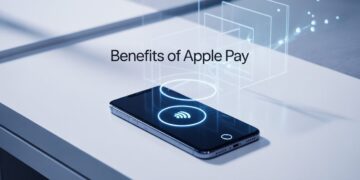Many consumers shop and browse products using their phones and other mobile devices. Today, mobile commerce is more crucial than ever. To better understand what mobile commerce is and how it is evolving, look at some of the most excellent M-commerce applications.
M-commerce is a helpful technology that impacts how you interact with your audience and client base.
What is m-commerce?
M-commerce is online business transactions using portable, wireless devices like tablets, smartphones, and PDAs. This is an electronic commerce feature that operates on mobile devices. A firm can reach more clients online via m-commerce. Customers can choose from various products and payment methods offered by various merchants.
What makes m-commerce significant?
In today’s mobile world, m-commerce is one of the main factors that spurs business growth. Small and large ecommerce companies alike discover that mobile applications are an effective way to reach a broader audience with their marketing messages. The market for online sales is expanding rapidly these days. Online retailers gravitate toward offering their clients greater ease to foster consumer loyalty and guarantee sales in this digital age. Creating an e-commerce space that is easily accessible to the majority of people and allows everyone to purchase things, regardless of the device they use to shop online, is the best approach to do this.
Expanding the consumer base and generating additional prospects is the ultimate purpose of starting an Internet store. Both increasing revenue and reaching new target audiences can be achieved through online selling. Online merchants can also reach a wider audience of customers by establishing an e-commerce website than only their physical storefronts. Additionally, by going mobile, their chances of generating sales increase by double because modern consumers value convenience, and what could be more convenient than being able to shop whenever and wherever—on a bus, in a park, or even just lounging on the couch? It sure looks soothing. That’s what m-commerce does; it improves the purchasing experience by substituting convenience for laborious tasks.
Pros of M-commerce:
- It offers an efficient and user-friendly framework for conducting business.
- The reach of mobile commerce is extensive. Most people on the planet carry a cell phone in their pocket. Thus, the market’s sheer magnitude is enormous.
- M-commerce facilitates firms to target clients based on many characteristics, including device kind, location, and service provider. This may work well as a marketing technique.
- The company’s expenses decreased as well. The streamlined procedures, low carrying costs, low order processing costs, and transaction costs bring this about.
Cons of M-commerce:
- The current technology for launching an online store is relatively inexpensive. It has high startup expenses and frequently encounters difficulties.
- Networks and service providers could be more reliable in emerging nations. There are better options for transferring data.
- And there’s the security concern. The security of the private information belonging to the customers is a significant worry. Moreover, the prospect of a data leak is highly unsettling.
Key m-commerce areas include:
Perusing and purchasing:
In this type of m-commerce, the customer browses apps, navigates mobile websites, and makes purchases, much like in a desktop e-commerce flow. Usually, it can also happen through specialized apps as a “social commerce” transaction, with in-app purchasing possibilities provided by social media sites like TikTok, Instagram, and Snapchat.
Buying convenience goods:
Many purchases made on mobile devices are unrelated to retail, and m-commerce is not limited to “shopping” in the traditional sense. These purchases include ride-sharing or taxi services and food or grocery delivery orders.
Wallet payments and payments using mobile apps:
An m-commerce transaction can be made in several methods, and the use of digital wallets is rising. Rather than entering credit card information into every app separately, users can load their digital wallet (as an overlay or popup) and make purchases with a single click or by just using their thumbprint.
Digital media (renting and buying):
Subscription apps are prevalent on mobile devices, usually featuring music and video (think Netflix and Spotify). After paying a monthly fee, users can use their mobile app to access a vast content library.
What are some of the most widely used m-commerce apps?
Check out these instances of well-known m-commerce apps:
- Chime, Capital One, and Ally Bank offer mobile banking.
- Mobile Booking and Ticketing (Booking.com, Airbnb, Skyscanner)
- E-bills, for instance, loyalty points (Rakuten, Honey, SavingStar), mobile coupons, and vouchers
- Auctions (eBay, eBay, Tophatter) Stock Market Reports (MarketWatch, Yahoo! Finance, Robinhood).
- Page Speed’s Effect on Mobile Commerce
- Page load time has always affected an e-commerce site’s Google ranking for desktop computers; the quicker the page loads, the more probable the site will rank higher.
- However, Google recently switched to a mobile-first index in response to m-commerce, which means that mobile-friendly online retailers would naturally rank higher than those that are not.
- Page speed impacts more than just SEO ranking, of course.
- Google conducted a study that found that for every few seconds the page loads, there is a significant rise in the likelihood that a user will bounce.
What role does M Business play?
M-business can assist SMBs in focusing on clients who access information, goods, and services via wireless and mobile devices. A small firm could, for instance, develop a smartphone app that lets users put money into an e-purse and use it to make purchases on their smartphones.
In Conclusion:
To sum up, mobile commerce, or m-commerce has completely changed how we shop and do business. Thanks to the growing use of smartphones and mobile apps, customers may now easily explore, shop, and handle transactions on their mobile devices. Customers have profited from this ease, but businesses have also gained new chances to expand their consumer base and improve their sales tactics. As technology develops, m-commerce has a bright future and will play a crucial role in the contemporary economy.
FAQs:
What is m-commerce?
M-commerce, or mobile commerce, is the term for business using mobile devices like tablets and smartphones. It includes things like mobile payments, mobile banking, and internet shopping.
What distinguishes m-commerce from e-commerce?
A subclass of electronic commerce known as “m-commerce” focuses exclusively on mobile device transactions. M-commerce is explicitly designed for mobile user experiences, whereas e-commerce can involve online shopping on PCs and laptops.
What benefits does mobile commerce offer?
With m-commerce, consumers can purchase and make payments from anywhere at any time, which is convenient. Additionally, it offers advertising tailored to mobile devices, individualized experiences, and rapid access to product details.
Which m-commerce applications are popular?
Mobile banking apps, mobile wallet services (like Apple Pay and Google Pay), mobile shopping apps (like Amazon and eBay), and food delivery apps (like Uber Eats) are examples of typical m-commerce applications.
Is m-commerce safe?
Security is a top priority for m-commerce systems using secure payment gateways, authentication techniques, and encryption. But consumers should also exercise prudence, like creating secure passwords and keeping their gadgets safe.
What difficulties does m-commerce present?
Ensuring compatibility across several mobile devices and operating systems, addressing security issues, and optimizing websites and apps for mobile screens are some challenges in m-commerce.
What effects has the rise of m-commerce had on conventional retail?
Traditional retail has changed due to m-commerce, which has forced companies to implement online and mobile strategies. Many physical establishments now have an online and mobile presence to remain competitive.









